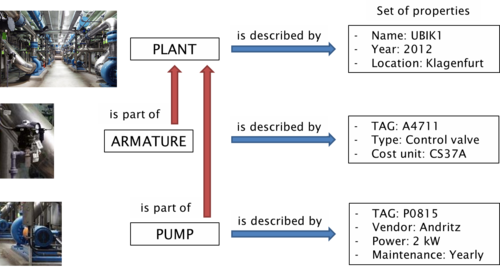Entity Data Model
Introduction
Objectives
In an industrial environment we quite often need to
- describe an industrial plant consisting of a bunch of different parts, each having a certain purpose and set of properties, and which are related in various ways
- manage process or maintenance data of the plant and its features
- do a high-performance cost-benefit analysis and create key performance indicators
Therefore we need to
15 px „Dissemble“ the system into theoretical blocks representing the real as well as intangible parts of the system.
15 px Identify the necessary properties of the blocks.
15 px Think about how blocks are possibly related to each other.
15 px Think about the functions and features of blocks.
Plant picture
Lets start with a simple picture and have a look what blocks we find in a possible plant

A closer look at the "PUMP" block reveals its properties and property values

Of course, a plant consists of multiple pumps, each described with the same set of properties (TAG, vendor, power, maintenance data). The real pumps in the plant are distinguished by different property values as given in the table.
| Pump | TAG | Vendor | Power | Maintenance |
|---|---|---|---|---|
| #1 | P0815 | Andritz | 2 kW | Yearly |
| #2 | P0816 | Andritz | 5 kW | Monthly |
| #2 | P0817 | Sulzer | 4 kW | Yearly |
We can redefine or extend our objectives by
15 px
Design a descriptive model including all required blocks and properties of the system
15 px An object in this model specifies possible properties for a certain part of the real system
</font>
